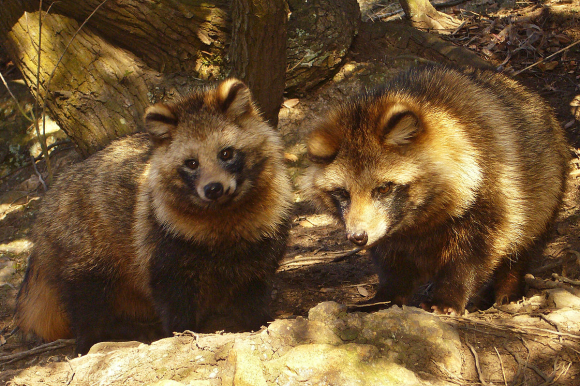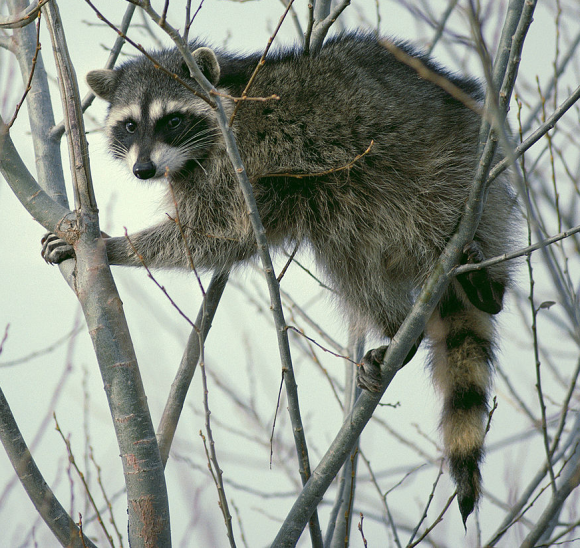
They may look similar at first glance, but the two separate species of forest critters have a handful of key differences.
Back in the fourth grade, Super Mario Bros. 3 taught me a lot of things. For example, I learned that sometimes the kid on the playground who swears his dad took a trip to Asia and brought back some awesome Nintendo game that’s not out in America yet really is telling the truth. I learned that it actually is possible for a sequel to surpass the original.
And I learned that in Japan there’s an animal called the tanuki.
As I got older and my knowledge of Japan grew, I found out that, in stark contrast to Tanooki Mario, real-life tanuki aren’t able to fly or transform into invincible statues. As a matter of fact, some of the Japanese-English dictionaries and vocabulary lists I looked at said that tanuki were just raccoons.
That translation isn’t entirely accurate, though. Tanuki are technically “raccoon dogs,” classified as members of the family Canidae, making them closer relatives to dogs, wolves, and foxes than they are to raccoons. Still, the visual similarity between tanuki and raccoons is strong enough that it can be hard to tell the two species apart, unless you’ve got a handy guide like this one.
https://twitter.com/namagaki0521/status/800685183074582528Shared by Japanese Twitter user @namagaki0521, the side-by-side comparison shows a raccoon on the left and a tanuki on the right. The listed differences are:
● Head
Raccoon: White-edged ears, black stripe running down forehead, white whiskers
Tanuki: Black-edged ears, no forehead stripe, black whiskers
▼ Forehead stripe = racoon
● Body
Raccoon: 42-60 centimeters (16.5-23..6 inches) in length, bushy stiped tail
Tanuki: 50-60 centimeters in length, short tail with no stripes
● Legs/feet
Raccoon: Fur on legs matches color of fur on body, five digits allows for skillful gripping of objects
Tanuki: Black fur on legs, four digits (like a dog or fox)
Of course, while zoologists are familiar with these differences, many laymen, even in Japan, don’t have the discrepancies memorized. As such, it can sometimes be hard to tell if a drawing, produced by an artist instead of a naturalist, is supposed to be a tanuki or a raccoon (even Tanooki Mario mistakenly has a striped tail). So when in doubt, check for the illustrated tanuki’s unmistakable giveaway: massive balls.
Source: Twitter/@namagaki0521
Top image: Wikimedia Commons/663highland
Insert image: Wikipedia/Novil Ariandis
Follow Casey on Twitter, where as long as we’re mashing together animal names like “raccoon dog” he’d like to see a “killer whale wolf.”


 Tanuki teamwork! Japanese raccoon dogs’ cuddly communal nap is too cute to miss 【Photos】
Tanuki teamwork! Japanese raccoon dogs’ cuddly communal nap is too cute to miss 【Photos】 Japanese family find creatives solution after “tanuki” sends daughter letter, promises play date
Japanese family find creatives solution after “tanuki” sends daughter letter, promises play date Japanese tanuki heads for the ticket gates at Shinjuku Station in Tokyo【Video】
Japanese tanuki heads for the ticket gates at Shinjuku Station in Tokyo【Video】 Turning a crazy cheap country Japanese house into a home — Step 4: Ghost Hunting【SoraHouse】
Turning a crazy cheap country Japanese house into a home — Step 4: Ghost Hunting【SoraHouse】 Tanuki warming itself in front of heater warms the hearts of Japanese Twitter users 【Pics】
Tanuki warming itself in front of heater warms the hearts of Japanese Twitter users 【Pics】 Ramen restaurant’s English menu prices are nearly double its Japanese ones, denies discriminating
Ramen restaurant’s English menu prices are nearly double its Japanese ones, denies discriminating Here’s what our bachelor writers ate over the New Year’s holiday in Japan
Here’s what our bachelor writers ate over the New Year’s holiday in Japan Nearly one in ten young adults living in Japan isn’t ethnically Japanese, statistics show
Nearly one in ten young adults living in Japan isn’t ethnically Japanese, statistics show What makes a good boss in Japan? Workers sound off in survey
What makes a good boss in Japan? Workers sound off in survey Feast your eyes on yet more adorable 8-bit GIFs depicting daily life in Japan
Feast your eyes on yet more adorable 8-bit GIFs depicting daily life in Japan Top Japanese cosplayer Enako returns to Comiket after 6 years, creates mayhem with admirers
Top Japanese cosplayer Enako returns to Comiket after 6 years, creates mayhem with admirers Expensive Japanese nail clippers: Are they worth it?
Expensive Japanese nail clippers: Are they worth it? Kyoto samurai house wants to share its history of seppuku, torture and gold coins with visitors
Kyoto samurai house wants to share its history of seppuku, torture and gold coins with visitors Japanese police to use AI to search social media posts for potential terrorists
Japanese police to use AI to search social media posts for potential terrorists Village Vanguard’s “dangerous” lucky bag promises thrilling highs and miserable lows
Village Vanguard’s “dangerous” lucky bag promises thrilling highs and miserable lows Japanese beef bowl chain Sukiya’s 2026 Smile Box lucky bag basically pays for itself
Japanese beef bowl chain Sukiya’s 2026 Smile Box lucky bag basically pays for itself Starbucks Japan ready to get Year of the Horse started with adorable drinkware and plushies【Pics】
Starbucks Japan ready to get Year of the Horse started with adorable drinkware and plushies【Pics】 Hayao Miyazaki says Happy New Year to Studio Ghibli fans with new art for Year of the Horse
Hayao Miyazaki says Happy New Year to Studio Ghibli fans with new art for Year of the Horse Cup Noodle tries an authentic Jiro-style ramen, but something’s not quite right
Cup Noodle tries an authentic Jiro-style ramen, but something’s not quite right The best Starbucks Japan Frappuccinos we want to drink again in 2026
The best Starbucks Japan Frappuccinos we want to drink again in 2026 We revisited Sweets Paradise after a decade to see if Japan’s dessert buffet still delivers
We revisited Sweets Paradise after a decade to see if Japan’s dessert buffet still delivers That time Seiji called JASRAC to ask why he didn’t get paid royalties for his song being on TV
That time Seiji called JASRAC to ask why he didn’t get paid royalties for his song being on TV Pizza Hut Japan’s hot lucky bags are perfect for a New Year’s pizza party
Pizza Hut Japan’s hot lucky bags are perfect for a New Year’s pizza party Majority of Japanese mayors say foreign residents are essential but most see good and bad effects
Majority of Japanese mayors say foreign residents are essential but most see good and bad effects 7-Eleven Japan starts new temporary luggage storage service in over 300 branches
7-Eleven Japan starts new temporary luggage storage service in over 300 branches Disillusionment at Tsukiji’s tourist-target prices led us to a great ramen restaurant in Tokyo
Disillusionment at Tsukiji’s tourist-target prices led us to a great ramen restaurant in Tokyo Starbucks teams up with 166-year-old Kyoto doll maker for Year of the Horse decorations【Photos】
Starbucks teams up with 166-year-old Kyoto doll maker for Year of the Horse decorations【Photos】 Tokyo considering law requiring more trash cans following litter increase in heavily touristed area
Tokyo considering law requiring more trash cans following litter increase in heavily touristed area Tokyo’s Tsukiji sushi neighborhood asks tour groups to stay away for the rest of the month
Tokyo’s Tsukiji sushi neighborhood asks tour groups to stay away for the rest of the month Tokyo event lets you travel back in time, for free, to celebrate 100 years since Showa era start
Tokyo event lets you travel back in time, for free, to celebrate 100 years since Showa era start Japan may add Japanese language proficiency, lifestyle classes to permanent foreign resident requirements
Japan may add Japanese language proficiency, lifestyle classes to permanent foreign resident requirements Sanrio theme park in Japan announces plans to expand into a Sanrio resort
Sanrio theme park in Japan announces plans to expand into a Sanrio resort Lacquerware supplier to emperor of Japan and Pokémon team up for new tableware
Lacquerware supplier to emperor of Japan and Pokémon team up for new tableware Survey asks foreign tourists what bothered them in Japan, more than half gave same answer
Survey asks foreign tourists what bothered them in Japan, more than half gave same answer Japan’s human washing machines will go on sale to general public, demos to be held in Tokyo
Japan’s human washing machines will go on sale to general public, demos to be held in Tokyo Japan’s deadliest food claims more victims, but why do people keep eating it for New Year’s?
Japan’s deadliest food claims more victims, but why do people keep eating it for New Year’s? We deeply regret going into this tunnel on our walk in the mountains of Japan
We deeply regret going into this tunnel on our walk in the mountains of Japan Studio Ghibli releases Kodama forest spirits from Princess Mononoke to light up your home
Studio Ghibli releases Kodama forest spirits from Princess Mononoke to light up your home Major Japanese hotel chain says reservations via overseas booking sites may not be valid
Major Japanese hotel chain says reservations via overseas booking sites may not be valid Put sesame oil in your coffee? Japanese maker says it’s the best way to start your day【Taste test】
Put sesame oil in your coffee? Japanese maker says it’s the best way to start your day【Taste test】 No more using real katana for tourism activities, Japan’s National Police Agency says
No more using real katana for tourism activities, Japan’s National Police Agency says Starbucks Japan reveals new sakura drinkware collection, inspired by evening cherry blossoms
Starbucks Japan reveals new sakura drinkware collection, inspired by evening cherry blossoms Updated cherry blossom forecast shows extra-long sakura season for Japan this year
Updated cherry blossom forecast shows extra-long sakura season for Japan this year
Leave a Reply